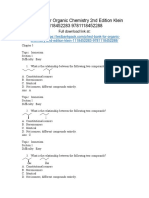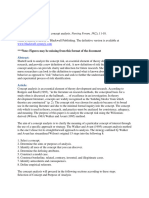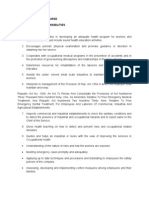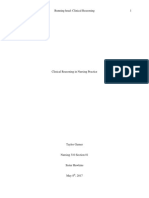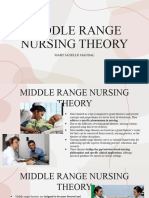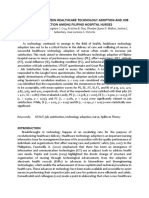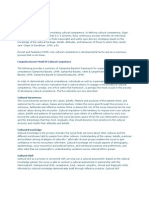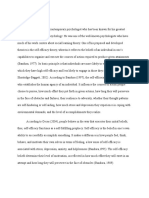Theory Critique
Theory Critique
Uploaded by
Arceo AbiGailCopyright:
Available Formats
Theory Critique
Theory Critique
Uploaded by
Arceo AbiGailOriginal Description:
Copyright
Available Formats
Share this document
Did you find this document useful?
Is this content inappropriate?
Copyright:
Available Formats
Theory Critique
Theory Critique
Uploaded by
Arceo AbiGailCopyright:
Available Formats
THEORY OF CARING A CRITIQUE 1
Running Head: THEORY OF CARING A CRITIQUE
Kristen Swansons Middle Range Theory of Caring: A Critique
Lisa Armstrong
NURS 900.01: Discipline of Nursing (Fall 2012)
November 24, 2012
Dr. J. Samuels
THEORY OF CARING A CRITIQUE 2
Kristen Swansons Middle Range Theory of Caring: A Critique
Introduction
Caring Profession Definition
A profession that involves taking care of other people. For example: social work and
nursing (Macmillan Dictionary, 2012)
Type the word caring into the CINAHL database and it returns 24,828 results. Type it
into Google, and the figure rockets to over 42 million. Its a fair assumption to make that the
world cares about caring. Indeed, the concepts of care and caring are synonymous with the
medical and nursing profession. In fact, society has long coupled the word health with care,
and the word healthcare is well on its way to becoming a noun and adjective in its own right
(Grammarist.com, 2012). Another more recent example of word coupling with care is the new
Patient Protection and Affordable Care Act euphemized Obamacare; yet another illustration of
the ubiquitous association of the interrelated concepts of care and health within western
contemporary society.
As the cornerstone of nursing, the tenets of caring are described extensively in various
guises and across multiple sources, both old and new. One of nursings earliest grand theorists;
Dr. Jean Watson formalized and presented her own Theory of Transpersonal Caring in 1979. An
exciting and revolutionary grand theory that has stood the test of time, Watsons
accomplishments are evidenced by the extensive use of her works in current nursing literature
over the last three decades, as well as her 2012 Speaking Engagements Calendar
(watsoncaringscience.org, 2012), which demonstrates Watsons influence on an international
THEORY OF CARING A CRITIQUE 3
stage as her teachings reach audiences across the globe from the United States and the United
Kingdom, to Mexico, Venezuela, and Italy.
The application of caring theory transcends many different health disciplines and health
care systems worldwide, including nursing. A relatively limited literature review reveals that
Watsons grand theory has been the inspiration and formed guiding practices for many current
middle-range caring theories, such as Falk-Rafaels Critical Caring Theory (2005) in acute care,
Kolcabas Comfort Theory (2001) in palliative care, and Wade and Kaspers Nursing Students
Perceptions of Instructor Caring (2006) in education to name but a few, demonstrating the wide
breadth of application diversity.
One such Watson inspired middle-range theory that is particularly versatile in its
application within the nursing arena is that of Kristen Swansons middle-range Theory of Caring.
Swansons theory has demonstrated its ability to be broadly generalizable across different
populations (Chinn & Kramer, 2011, p. 49) and meets the middle-range standard for having a
high explanatory value in the understanding of different phenomena and rather easily applied in
practice (Andershed & Olsson, 2009, p. 598).
This paper discusses the extent of application of Swansons Theory of Caring within the
nursing profession, provides an overview of the theory, a critical analysis, and considers the
theorys application within contemporary nursing practice and institutional health care settings.
The Theorist: Kristen Swanson
Kristen M. Swanson, RN, PhD, FAAN, is the Dean of the School of Nursing, Alumni
Distinguished Professor at the University of North Carolina at Chapel Hill, and Associate Chief
Nursing Officer for Academic Affairs at UNC Hospitals. She earned her bachelor degree in
THEORY OF CARING A CRITIQUE 4
nursing from the University of Rhode Island in 1975, her masters in adult health and illness
nursing from the University of Pennsylvania in 1978, and a PhD in psycho-social nursing from
the University of Colorado, completing her postdoctoral work at the University of Washington
(University of North Carolina, 2012; Ray, 2011).
Her theory was empirically developed out of three phenomenological studies in separate
perinatal contexts carried out in the late eighties and was further developed and refined during
the early nineties. Numerous hospitals and health care facilities have since adopted Swansons
theory of care as a guide to their own nursing services (Ray, 2011) and Swanson continues to
consult internationally on implementation of caring theory in clinical practice, research, and
education (University of North Carolina, 2012).
Theory Description
Foundation and Historical Evolution
Swanson started out with a deep interest in understanding what is was like for women to
miscarry (Swanson, 1998) and her caring theory was initially founded through her doctoral
work into exploring what caring meant from the perception of women who had miscarried. As a
result of her own personal experience with her second newborn child in a NICU setting, her
subsequent post-doctoral research led Swanson into the study of nursing care within a NICU
environment, and her third study focused on high risk mothers within a public health setting.
Initial concepts were formulated during her early studies, and as her research progressed
Swanson further clarified and honed the five theoretical categories of caring. As the theory has
been further referenced, applied to practice, validated, and tested in several different
environments over the last two decades, it has without doubt matured and developed, but the five
key categories remain inherently the same.
THEORY OF CARING A CRITIQUE 5
Theory Structure, Concepts, and Definitions
Figure 1: Nursing as Informed Caring for the Well-Being of Others, Swanson, 1993, p. 355
The proposed structure of the theory depicts caring as grounded in maintenance of a
basic belief in persons, anchored by knowing the others reality, conveyed through being with,
and enacted through doing for, and enabling (Swanson, 1993, p. 354).
Knowing is striving to understand an event as it has meaning in the life of the other. It
involves avoiding assumptions, centering on the one(s) cared for, thoroughly assessing all
aspects of the clients condition and reality, and ultimately engaging the self or personhood of the
nurse and client in a caring transaction (Swanson, 1998, p. 355).
Being With means being emotionally present as a way of sharing in the meanings,
feelings, and lived experience of the one-cared fornot just the side-by-side physical presence,
but also the clearly conveyed message of availability and ability to endure with the other
(Swanson, 1998, p. 355).
Doing For is doing for the other what they would do for themselves if it were at all
possibleand includes comforting the other, anticipating their needs, performing competently
and skillfully, protecting the other from undue harm and ultimately preserving the dignity of the
one done for (Swanson, 1998, p. 356)
THEORY OF CARING A CRITIQUE 6
Enabling helps the other to practice self care, defined as facilitating the others passage
through life transitions and unfamiliar events, including coaching, informing, and explaining to
the other; supporting the other and allowing her/him to have her/his experience; assisting the
other to focus in on important issues; helping her/him to generate alternatives; guiding her/him to
think issues through; offering feedback; and validating the others reality (Swanson, 1998, p.
356).
Maintaining Belief is sustaining faith in the others capacity to get through an event or
transition and face a future with meaning. In a 1998 Caring Made Visible interview, Swanson
discussed that she had broadened this category to add helping find meaning through affirming
the others experience and the meaning they derive, which may involve working with people
around their religious and spiritual needs (Swanson, 1998, p. 354).
The theory structure and concepts underpin the authors definition of caring: Caring is a
nurturing way of relating to a valued other person, towards whom one feels a personal sense of
commitment and responsibility (Swanson, 1991, p. 165).
Purpose of the Theory
Swanson states that the five caring processes are not suggested to be unique to nursing,
but are proposed as common features of caring relationships. However, in the context of nursing
practice, the theory provides broad guidance for what are considered central caring behaviors
that a nurse may undertake in his/her relationship with self, client, and nurse colleagues. The
theory helps to facilitate the incorporation of these caring behaviors into daily nursing practice,
ensuring that the mainstay of attention remains on the one cared for during all nursing
THEORY OF CARING A CRITIQUE 7
interactions.
Furthermore, the theory embodies the notion that the nurse and the one cared for
are relating to each other and engaged in the process of caring together, culminating in a
meaningful relationship and fostering a mutually beneficial desired outcome.
Theory Relationships
Swanson identifies key relationships that interrelate with the Theory of Caring; persons,
health/wellbeing, environment, and nursing. Persons may be an individual, or perhaps an
aggregate of individuals, such as families, groups, or societies. Persons may also incorporate
future generations or social issues such as access to healthcare. Self is also conceptually
regarded in the person category.
Environmental relationships are key to caring, and also crucial to the application of
Swansons Theory of Caring. Swanson notes that realms of influence are multiple including the
cultural, political, economic, social, biophysical, psychological, and spiritual realms, (1993,
p353) recognizing that what is considered client in some situations may serve as context or
environment in others, such as community endeavors, school systems, and so forth.
Health and well-being are also relationships that intertwine with the theory. All five
processes contribute to assisting clients to attain, maintain, or regain the optimal level of living
or wellbeing they choose given their personal and environmental demands, constraints, and
resources (Swanson, 1993, p. 353).
Finally, Swanson discusses the relationship of nursing and informed caring, clarifying
informed nurse caring as ranging from having novice to expert capacity in practice, and that such
therapeutic practices of nurses are grounded in knowledge of nursing, related sciences and the
humanities, as well as personal insight and experiential understanding.
THEORY OF CARING A CRITIQUE 8
Critical Reflection
Clarity
Swansons theory of caring clearly delineates boundaries in each of the five subcategories
of caring by identifying, describing, and giving examples of caring behaviors that fulfill each
caring process, reducing the risk of ambiguity. An example of enabling is clarified as:
Providing information and explanations as well as offering emotional support in the
form of allowing and validating the others feelings. Enabling often includes assisting
the ones cared for to focus on their concerns, generate alternatives, and think through
ways to look at or act on a situation (Swanson, 1991, p. 164)
Consistency
Although Swansons theory has developed over the years to further enhance individual
descriptive components of each process, the main five concepts have remained static. An
example of this maturation process is the addition of helping find meaning in the Maintaining
Belief process, which includes affirming the clients experience and the meaning they derive from
it, as well as being cognizant of an individuals spiritual and religious needs (Swanson, 1998).
Perhaps part of the strength of this theory is that the fundamental basic constructs have remained
relatively unchanged over time, and yet the theory has been able to adapt to new and everevolving practice settings, and from within these different environments grow and change to
deliver a more generalizable theory, while still remaining recognizable in its original form.
Additionally, Swansons theoretical constructs reflect and remain consistent with Jean
Watsons grand Theory of Transpersonal Caring, and the two are often cited together (Mason &
Wesorick, 2011, Blessing Hospital, 2012, Winter Haven Hospital, 2012). As a result of this
relationship, Swansons theory is further endowed with a higher level of credibility.
THEORY OF CARING A CRITIQUE 9
Complexity
What makes Swansons theory so easily applicable within nursing practice is its
simplicity and clarity, especially from a lay perspective. Each process is explicitly defined,
providing a caring road map that both the person delivering the care, and the one being cared for,
can understand, relate to, agree upon, and engage in.
Interestingly, the theory is able to become more or less complex as it is applied to any
unique caring context. For example, the basic processes can be described at a macro level in
terms of an overarching goal for care delivery from a global perspective consider the
possibility that the World Health Organization could advocate for one specific caring theory for
example -- or at an institutional level within the construct of a theoretical framework for care
delivery. Conversely, it can also be engaged within a micro system setting, as the theory is
utilized in a specific clinical context, such as a model for the delivery of care for persons with
dementia, or within the context of caring for high-risk families, as has been demonstrated.
Application and Generalizability
Swansons theory was originally conceived within a perinatal concept, but has been
successfully applied across the spectrum of nursing care during the last two decades including
palliative care, mental disorders, dementia, parental support groups, home care, and critical care
amongst numerous others, demonstrating a parsimonious theory that boasts a broad diversity of
application within the context of nursing practice.
Additionally, in their Review of Research related to Kristen Swansons middle-range
theory of caring article, Andershed and Olssen (2009) highlighted six high quality studies that
focused on developing measurements from and/or testing Swansons theory of caring, and
THEORY OF CARING A CRITIQUE 10
concluded that her theory of caring provided both a conceptual framework and empirical
support for the generalizability of the theory beyond the clinical contexts from which it was
generated (p. 608).
Swanson was also recently named as Virginia Masons Distinguished Nursing Scholar in
August 2012. Virginia Mason Medical Center uses the tools of the Virginia Mason Production
System which are based upon applying the principles of Toyotas production system to provide
better, safer, and more affordable care. Launching their new model of nursing care, Chief
Nursing Officer Charleen Tachibana states that Swansons Theory of Caring gives [Virginia
Mason nurses] the right context at the bedside to deliver the best care possible (Virginia Mason
Medical Center, 2012). Swanson further asserts that the Virginia Mason Production System has
all of the tools necessary to take my Theory of Caring and make it the Practice of Caring
(Virgina Mason Medical Center, 2012). This is a perfect example of Swansons theory being
applied in a contemporary practice setting.
Another application example is that of Exeter Hospital, which currently utilizes
Swansons theoretical constructs within a relationship based care framework towards their goal
of Magnet Hospital status:
The shared vision for the Relationship Based Care framework is that the interaction
between the patient and the clinical care team members forms the basis of a knowing and
caring relationship. This relationship leads to a high level of engagement between
patients and care team members, and is the foundation of the patient care experience
(Exeterhospital.com, 2012).
Swansons processes are clearly defined within the missions, vision, and values statements as
they relate to the patient care experience. Similar statements can be found on multiple hospital
websites nationally (University of North Carolina, 2012, Virginia Mason Medical Center, 2012,
Winter Haven Hospital, 2012, Exeter Hospital, 2012, Blessing Hospital, 2012, Abbot
THEORY OF CARING A CRITIQUE 11
Northwestern Hospital, 2012, Lahey Clinic, 2012) and even internationally (Craigavon Area
Hospital Group Trust, Northern Ireland, 2012).
Accessibility
The Theory of Caring has demonstrated itself to be easily accessible across many
different practice settings. Clear conceptual definitions and guidelines easily translate to
observable and measurable nursing behaviors and client outcomes, making the theory a positive
choice for high quality nursing practice implementation.
Additionally, the theory has also been featured within international research including the
United States, Europe, Canada, Australia, New Zealand, Asia, and Israel, as well as presented in
at least nine different nursing related journals (Andershed & Olsson, 2009), demonstrating its
eminent level of credibility and versatility.
Research Guidance and Practice
An exemplar of Swansons theory in research guidance and practice can be found in
Amendolairs (2011) recent study Caring Model: Putting Research into Practice. This study
clearly demonstrates the application of Swansons theory through the successful design and
implementation of an institutional care model that reflects staff nurse perceptions of what nursing
means to them. The author concludes that Swansons model is a demonstration of the link
between theory and practice, and that the theory constructs provide a clear description of what
caring means and how nurses exhibit caring in their everyday practice. As concern grows about
clinical relevance of theory and research within practice settings (Chinn and Kramer, 2011),
these types of qualitative studies are imperative in demonstrating the powerful link between
theoretical constructs and evidence-based nursing practice.
THEORY OF CARING A CRITIQUE 12
Importance in Nursing
Chinn and Kramer (2011) designate theory importance as forward looking; useable in
practice, education, and research; and valuable for creating a desired future (p. 204). Since the
Theory of Carings conception in 1991, Swanson, and other notable nursing scholars have
continued to make strides in advancing the theory within a variety of nursing contexts, and
continuously engage in and encourage the theorys adaptation and growth within contemporary
nursing practice. Cited within more than 120 published articles and featured in numerous
nursing science, scholarship, clinical, and research journals, the theory more than meets the
criteria for being usable in practice, education and research.
Also widely utilized within institutional settings (Virginia Mason Medical Center, 2012,
Winter Haven Hospital, 2012, Exeter Hospital, 2012, Blessing Hospital, 2012, Abbot
Northwestern Hospital, 2012, Lahey Clinic, 2012) and championed as an exemplar of clinical
practice models by professional nursing bodies (Mason & Wesorick, 2011, NMAHP Quality
Council, 2011), the theory is without doubt forward looking and valuable for creating a desired
future towards the practice of informed nurse caring at the bedside in the twenty first century.
Conclusion
Perhaps one of the most versatile middle-range nurse caring theories to come out of the
twentieth century, Swansons Theory of Caring is an exemplar model of a substantive middlerange theory that can inform practice and lead to new practice approaches as well as investigate
factors that influence the outcomes that are desired in nursing practice (Chinn & Kramer,
20011, p. 48). Utilized within multiple clinical settings across the globe, the theory is proven to
be a highly valuable and clinically relevant theory for modern day nursing practice and research.
THEORY OF CARING A CRITIQUE 13
References:
Abbot Northwestern Hospital. 2012. Nursing Department: Relationship
Based Care Model. Retrieved Nov 21, 2012 from
http://www.allinahealth.org/ahs/anw.nsf/page/rel_based.pdf/
$FILE/rel_based.pdf
Amendolair, D. (2011). Caring Model: Putting Research into Practice. International
Journal For Human Caring, 15(3), 49-56.
Andershed, B., & Olsson, K. (2009). Review of research related to Kristen Swansons
middle-range theory of caring. Scandinavian Journal Of Caring Sciences, 23(3), 598-610.
doi:10.1111/j.1471-6712.2008.00647.x
Blessing Hospital. 2012. Nursing Care Philosophy. Retrieved Nov 21, 2012 from
http://www.blessinghospital.org/?id=301&sid=2
Chinn, P.L. & Kramer, M.K. (2011). Integrated theory and knowledge development in
nursing (8th ed.). St. Louis, MO: Mosby, Inc.
Exeter Hospital. 2012. Mission, Values and Theoretical Framework.
Retrieved Nov 21, 2012 from http://www.exeterhospital.com/aboutexeter/nursing/mission-values-framework/
Falk-Rafael, A. (2005). Advancing nursing theory through theory-guided practice: the
emergence of a critical caring perspective. Advances In Nursing Science, 28(1), 38-49.
THEORY OF CARING A CRITIQUE 14
Grammarist.com. 2012. Healthcare vs. health care. Retrieved Nov 21, 2012 from
http://grammarist.com/usage/healthcare/
Kolcaba, K., Tilton, C., & Drouin, C. (2006). Comfort theory: a unifying framework to
enhance the practice environment. Journal Of Nursing Administration, 36(11), 538-544.
Lahey Clinic. 2012. Professional Practice Model. Retrieved Nov 21, 2012 from
http://www.lahey.org/For_Healthcare_Professionals/Nursing/Professional_Practice_Model.aspx
Linda Ray, 2011. About Swansons Theory. Livestrong.com. Retrieved Nov 21, 2012
from http://www.livestrong.com/article/31652-swansons-theory/
Macmillan Dictionary. 2012. Caring Profession Definition. Retrieved Nov 21, 2012
from http://www.macmillandictionary.com/dictionary/british/caring-profession
Mason, J., & Wesorick, B. (2011). Successful Transformation of a Nursing Culture. Nurse
Leader, 9(2), 31-36. doi:10.1016/j.mnl.2011.01.001
NMAHP Quality Councils. 2011. The NMAHP Contribution to Quality Caring: The
Concepts, Behaviours, Influences, and Impact. Retrieved Nov 21, 2012 from
http://www.knowledge.scot.nhs.uk/media/CLT/ResourceUploads/1012888/Caring,%20concept,
%20behaviours,%20influences%20and%20impact26.pdf
Swanson, K. (1998). Caring Made Visible. Creative Nursing, 4(4), 8.
Swanson, K. (1993). Nursing as informed caring for the well-being of others. Image:
Journal Of Nursing Scholarship, 25(4), 352-357.
THEORY OF CARING A CRITIQUE 15
Swanson, K. (1991). Empirical development of a middle range theory of caring. Nursing
Research, 40(3), 161-166.
The Royal College of Midwives. 2012. Examining the extent to which Swansons theory
of caring and carpers ways of knowing can be identified in midwife led care. Retrieved Nov 21,
2012 from http://www.rcm.org.uk/midwives/features/spiritual-midwifery-on-thefarm/examining-the-extent-to-which-swansons-theory-of-caring-and-carpers-ways-of-knowingcan-be-identified-in-midwife-led-care/
University of North Carolina. 2012. Translating Caring Theory into Practice: The
Carolina Care Model. Retrieved Nov 21, 2012 from
http://www.unchealthcare.org/site/Nursing/nursingmedialibrary/articles/transltheory.pdf
University of North Carolina. 2012. UNC School of Nursing: Kristen Swanson Bio.
Retrieved Nov 21, 2012 from http://sonapps.unc.edu/alumni/pdf/swanson_bio.pdf
Virginia Mason Medical Center. 2012. Virginia Mason Launches New
Model of Nursing Care. Retrieved Nov 21, 2012 from
https://www.virginiamason.org/body.cfm?id=158&action=detail&ref=3774
Wade, G., & Kasper, N. (2006). Nursing students' perceptions of instructor caring: an
instrument based on Watson's theory of transpersonal caring. Journal Of Nursing Education,
45(5), 162-168.
Watson Caring Science Institute. 2012. Speaking Engagements. Retrieved Nov 21, 2012
from http://watsoncaringscience.org/index.cfm/category/158/speaking-engagements.cfm
THEORY OF CARING A CRITIQUE 16
Winter Haven Hospital. 2012. Model of Professional Nursing Care Delivery. Retrieved
Nov 21, 2012 from http://www.winterhavenhospital.org/docs/nursing/model_of_care.pdf
You might also like
- Organic Chemistry 2nd Edition Klein Test Bank 1Document35 pagesOrganic Chemistry 2nd Edition Klein Test Bank 1carolyn100% (74)
- Concept Analysis - ExampleDocument9 pagesConcept Analysis - ExampleHanan AlkorashyNo ratings yet
- Nursing Philosophy StatementDocument1 pageNursing Philosophy Statementapi-547001751No ratings yet
- 4 10 18 306 Transcultural PaperDocument6 pages4 10 18 306 Transcultural Paperapi-488513754No ratings yet
- Power Problems and UPS SolutionsDocument2 pagesPower Problems and UPS Solutionsdrastir_777100% (1)
- Swanson - Tee, GammadDocument9 pagesSwanson - Tee, GammadCheiramina Serolc EetNo ratings yet
- Personal PhilosophyDocument10 pagesPersonal Philosophyapi-283841044No ratings yet
- Reflections On Theory DevelopmentDocument3 pagesReflections On Theory DevelopmentDon Chiaw ManongdoNo ratings yet
- Final Course Requirment in Theoretical Foundation of Nursing - MunozDocument14 pagesFinal Course Requirment in Theoretical Foundation of Nursing - MunozDennis Nabor Muñoz, RN,RM100% (1)
- TFN LectureDocument20 pagesTFN LectureKathy EgamNo ratings yet
- Abdellah's TheoryDocument6 pagesAbdellah's TheoryBaldeep GrewalNo ratings yet
- Annotated Bibliography Paper #1 RevisedDocument11 pagesAnnotated Bibliography Paper #1 Revisedpotas abuyaNo ratings yet
- Capstone Clinical JudgmentDocument8 pagesCapstone Clinical Judgmentapi-455232702No ratings yet
- Nursing Theories and Advanced Practice.Document4 pagesNursing Theories and Advanced Practice.Antony Ombogo100% (1)
- Basic Principles of Nursing Care Volina ContinueDocument2 pagesBasic Principles of Nursing Care Volina Continuealena volinaNo ratings yet
- Learning Theories 1Document8 pagesLearning Theories 1api-258761055No ratings yet
- TFN 1 10Document44 pagesTFN 1 10Aaron TadenaNo ratings yet
- Whall Theory CritiqueDocument10 pagesWhall Theory Critiqueapi-273066575No ratings yet
- Advanced Practice NursingDocument11 pagesAdvanced Practice NursingSaher Kamal100% (2)
- Time To Learn. Understanding Patient Centered CareDocument7 pagesTime To Learn. Understanding Patient Centered CareAden DhenNo ratings yet
- Nursing Competency Standards in Primary Health Care - An IntegrativeDocument13 pagesNursing Competency Standards in Primary Health Care - An Integrativecarlos treichelNo ratings yet
- Occupation Health Nurse Functions and ResponsibilitiesDocument8 pagesOccupation Health Nurse Functions and ResponsibilitiesJezelle AbuanNo ratings yet
- Contribution of Nursing TheoristDocument9 pagesContribution of Nursing Theoristdantracy0% (1)
- Assignment 2 - Person Centred Care Case StudyDocument9 pagesAssignment 2 - Person Centred Care Case StudyEllie McGrory100% (1)
- Reed Self-Transcendence TheoryDocument2 pagesReed Self-Transcendence TheoryTrae StewartNo ratings yet
- Learning Theories and Higher EducationDocument17 pagesLearning Theories and Higher EducationRyan Michael OducadoNo ratings yet
- Self Care Defisit Nursing TheoryDocument9 pagesSelf Care Defisit Nursing TheoryiswantoNo ratings yet
- Concept of Peace in IslamDocument10 pagesConcept of Peace in IslamAdeniyi MajasanNo ratings yet
- Research Article CritiqueDocument12 pagesResearch Article Critiqueapi-336952692No ratings yet
- Kolcaba's Theory of ComfortDocument1 pageKolcaba's Theory of ComfortDanette Mae RocNo ratings yet
- The Theory of Technological Competency As Caring in Nursing GuidingDocument8 pagesThe Theory of Technological Competency As Caring in Nursing Guidingnot importantNo ratings yet
- Personal Philosophy of NursingDocument3 pagesPersonal Philosophy of Nursingapi-448020611No ratings yet
- Evidence-Based Nursing (Qualitative Research)Document6 pagesEvidence-Based Nursing (Qualitative Research)focus16hoursgmailcom100% (1)
- Theory of Interpersonal Relations-PeplauDocument35 pagesTheory of Interpersonal Relations-Peplaumel_pusag100% (2)
- 4 The Nursing Process Ppt2Document30 pages4 The Nursing Process Ppt2Marian Lirio100% (1)
- Trends in Nursing PracticeDocument12 pagesTrends in Nursing PracticeJerome Cid100% (1)
- Applying Lewins Change Management Theory To The Implementation of Bar-Coded Medication AdministrationDocument6 pagesApplying Lewins Change Management Theory To The Implementation of Bar-Coded Medication AdministrationgergisNo ratings yet
- Clinical Reasoning EssayDocument4 pagesClinical Reasoning Essayapi-363664052No ratings yet
- Nursing TheoristDocument27 pagesNursing TheoristThomas KimoloNo ratings yet
- Philosophy of Nursing EducationDocument6 pagesPhilosophy of Nursing Educationapi-216057141No ratings yet
- Betty Neuman Health Care System ModelDocument13 pagesBetty Neuman Health Care System ModelJoshua BalladNo ratings yet
- Hildgard PeplauDocument31 pagesHildgard PeplauHazel LezahNo ratings yet
- Nurising Assignment ConflictDocument10 pagesNurising Assignment ConflictLauren KalantaNo ratings yet
- OremDocument12 pagesOremprashanthNo ratings yet
- Environmental Model of NursingDocument23 pagesEnvironmental Model of NursingEntesarNo ratings yet
- Group 2 Middle Range TheoristDocument193 pagesGroup 2 Middle Range TheoristJosue Lucksley Efraim MaravillaNo ratings yet
- Faye G Abdellah Nursing TheoryDocument48 pagesFaye G Abdellah Nursing TheoryChandrashekar GajulaNo ratings yet
- Association Between Healthcare Technology Adoption and Job Satisfaction Among Filipino Hospital NursesDocument13 pagesAssociation Between Healthcare Technology Adoption and Job Satisfaction Among Filipino Hospital Nurseskaruro JorudenuNo ratings yet
- Foundations of The Specialty of Gerontologic Nursing - : 1961 Formation of A Specialty Group For Geriatric NursesDocument5 pagesFoundations of The Specialty of Gerontologic Nursing - : 1961 Formation of A Specialty Group For Geriatric NursesDan Dan ManaoisNo ratings yet
- Reflective Practice: Implication For NursesDocument6 pagesReflective Practice: Implication For NursesIOSRjournal100% (2)
- Cultural CompetenceDocument2 pagesCultural Competencered_rose50100% (1)
- Transtheoretical Model: Stephanie P. DayaganonDocument20 pagesTranstheoretical Model: Stephanie P. DayaganonSteph DayaganonNo ratings yet
- By: Jonalyn C. GalvezDocument60 pagesBy: Jonalyn C. GalvezvernaNo ratings yet
- TRanscultural Nursing CritiqueDocument3 pagesTRanscultural Nursing CritiquekyreNo ratings yet
- Middle Range Theories 23Document70 pagesMiddle Range Theories 23Dion Cabe100% (1)
- Change InitiativeDocument7 pagesChange InitiativeWajiha ShaikhNo ratings yet
- Paterson's Humanistic TheoryDocument16 pagesPaterson's Humanistic Theorypreet kaurNo ratings yet
- Futuristic NursingDocument11 pagesFuturistic NursingRoxana Mihaela MâțuNo ratings yet
- 4140 Personal Philosophy PaperDocument9 pages4140 Personal Philosophy Paperapi-507789841No ratings yet
- Fall Prevention Using TelemonitoringDocument14 pagesFall Prevention Using Telemonitoringapi-458433381No ratings yet
- Chronic Non-communicable Diseases in Ghana: Multidisciplinary PerspectivesFrom EverandChronic Non-communicable Diseases in Ghana: Multidisciplinary PerspectivesNo ratings yet
- Implementation PlanDocument50 pagesImplementation PlanArceo AbiGailNo ratings yet
- Flu Selfassess Flowchart PDFDocument1 pageFlu Selfassess Flowchart PDFArceo AbiGailNo ratings yet
- Co Operative Learning in The Teaching of Mathematics in Secondary EducationDocument29 pagesCo Operative Learning in The Teaching of Mathematics in Secondary EducationArceo AbiGailNo ratings yet
- Basic First Aid For KidsDocument40 pagesBasic First Aid For KidsArceo AbiGail0% (1)
- Pneumonia Case StudyDocument33 pagesPneumonia Case StudyArceo AbiGail100% (3)
- Operational Plan 1 Year Nurses: Capital: 1,000,000 PHPDocument2 pagesOperational Plan 1 Year Nurses: Capital: 1,000,000 PHPArceo AbiGailNo ratings yet
- Postpartum NCPDocument20 pagesPostpartum NCPapi-370148988% (34)
- Drinking Water StandardsDocument2 pagesDrinking Water StandardsCharan ReddyNo ratings yet
- Incident Command System ModulesDocument332 pagesIncident Command System ModulesCAP History Library100% (1)
- BWT Pharma and Biotech Company: Job ResponsibilitiesDocument1 pageBWT Pharma and Biotech Company: Job ResponsibilitiesBoruto UzumakiNo ratings yet
- Textures of Serpentinites OjoDocument30 pagesTextures of Serpentinites OjoRene Yasmany Rene YasmanyNo ratings yet
- Danger in The Desert Chapters 1 & 2Document15 pagesDanger in The Desert Chapters 1 & 2Lesia EnglishNo ratings yet
- Kamome CPP PropellerDocument6 pagesKamome CPP PropellerΟΔΥΣΣΕΑΣ ΜΠΟΥΓΙΑΣNo ratings yet
- De Thi Luyen Vao Chuyen 10 - 01Document8 pagesDe Thi Luyen Vao Chuyen 10 - 01Bích HiệpNo ratings yet
- s68 PDFDocument2 pagess68 PDFAnthemBeatsNo ratings yet
- Instant Up Right Cat 2015Document40 pagesInstant Up Right Cat 2015Krishnan SanthanarajNo ratings yet
- Federal Employees Farewell GrantDocument2 pagesFederal Employees Farewell Grantabubakar younasNo ratings yet
- 03 Thailand PTT Chemical Full ReportDocument24 pages03 Thailand PTT Chemical Full Reportahmed nawazNo ratings yet
- GUM Anton PaarDocument2 pagesGUM Anton PaarjarguedasNo ratings yet
- Total Energies OpportunitiesDocument1 pageTotal Energies OpportunitiesMark EtiebetNo ratings yet
- Sigma 2aDocument5 pagesSigma 2ayogeshkumar121998No ratings yet
- BAB IV Translate ArifDocument11 pagesBAB IV Translate ArifDoc Arif AkhmadNo ratings yet
- #7 - Practice Test 16Document2 pages#7 - Practice Test 16NguyễnHòaNo ratings yet
- Complaint For MISAPPROPRIEATION OF SHARE OF PROPERTYDocument5 pagesComplaint For MISAPPROPRIEATION OF SHARE OF PROPERTYSankar Nath ChakrabortyNo ratings yet
- StrawberriesDocument2 pagesStrawberriesAtali DaoudNo ratings yet
- Global Health and The Future Role of The United StatesDocument385 pagesGlobal Health and The Future Role of The United StatesDaniel MeloNo ratings yet
- Tijampi Technical ServicesDocument3 pagesTijampi Technical ServicesKevin SoteloNo ratings yet
- Hima Fscs - Tuv Fse White Papers 2012Document160 pagesHima Fscs - Tuv Fse White Papers 2012Luc Schram100% (1)
- Introduction To Microbiology and ParasitologyDocument26 pagesIntroduction To Microbiology and ParasitologyORTUOSTE ARIELLE ANNNo ratings yet
- Org 1 Unit 1 Structure and BondingDocument38 pagesOrg 1 Unit 1 Structure and BondingDonna ReeshaNo ratings yet
- Phase 1 Refined Problem StatementDocument15 pagesPhase 1 Refined Problem StatementVenugopal kulkarniNo ratings yet
- Banana Supply Chain - CADPDocument48 pagesBanana Supply Chain - CADPRaj K Adhikari100% (9)
- Bill of Materials Only UseDocument2 pagesBill of Materials Only Usepowder18No ratings yet
- Details of Donations Received For Covid - 19Document4 pagesDetails of Donations Received For Covid - 19SakshiNo ratings yet
- Self EfficacyDocument3 pagesSelf EfficacyKaye PeraltaNo ratings yet
